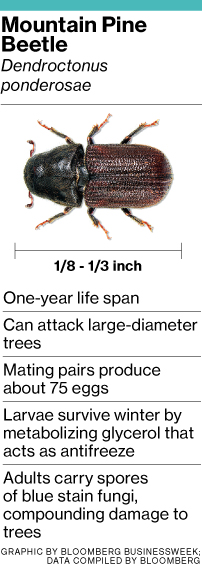The Beetle That’s Chewing Up America
Photograph by Brian Howell/USFS Rocky Mountain Region
Colorado’s Medicine Bow-Routt National Forest
The western U.S., already suffering an historic drought, is also battling another Old Testament-worthy plague: a tiny insect with a monster appetite. Pine beetles, each the size of a grain of rice, are obliterating forests, ravaging towns, draining city budgets, and threatening tourism at ski resorts, golf courses, and national parks. The beetles’ economic impact is emerging two decades into a growing infestation fueled by climate change and drought that has wiped out 38,000 square miles of trees—an area the size of Indiana and Rhode Island combined. Dead trees dominate vistas in the Rockies, Tetons, Cascades, and the Sierra Nevada.

Infestation and disease threaten 94 national forest areas in 35 states, U.S. Agriculture Secretary Tom Vilsack said during a May 20 visit to Denver. Colorado is one of the hardest-hit states, along with Wyoming and South Dakota. The insects have devoured 25 percent of the woods in South Dakota’s Black Hills, home of Mt. Rushmore. “It’s difficult to stop the spread,” says Bill Smith, the state Agriculture Department’s conservation program administrator. “What we’re trying to do is slow it down.”
In Colorado, the swaths of ruined forest increase the risk of wildfires. The U.S. Forest Service is designating 45 million acres nationwide for priority restoration, clearing deadwood and planting new trees. Democratic Governor John Hickenlooper said in a letter to Vilsack that 7 of the state’s 13 national forests have “experienced such massive infestation of beetles and other threats to their health they merit designation in their entirety.”
STORY: Behind the Story: A Visit to the Patagonia National Park-in-Progress
Recent winters haven’t been cold enough to kill off the beetles. The average U.S. temperature has increased by as much as 1.9 degrees Fahrenheit since 1895, with most of the warmest winters occurring since 1970, according to the National Climate Assessment the Obama administration issued in May. The warmer winters allow beetles to proliferate at higher elevations and latitudes, resulting in more generations per year in some areas, according to a 2011 Forest Service report.
Beetles have wiped out 4.5 million acres of trees in Colorado. Grand County has lost trees valued at more than $1 billion, according to researchers at Colorado State University in Fort Collins. The insects have chewed through 90 percent of the county’s mature lodgepole pine. At the 95-year-old C Lazy U Ranch, employees spend days clearing dead pines off riding trails. “We have an in-house logging crew—you are talking millions of dollars,” says Brady Johnson, sales and marketing director at the 11,000-acre Granby retreat. “Trees are falling down nonstop.” Voters in Grand Lake, a town of about 470, approved a $4.2 million bond in part to remove as many as 400,000 trees from its 500-acre golf course. Thirty-seven miles south in Winter Park, voters approved a property tax for beetle treatments.
“It’s difficult to stop the spread. What we’re trying to do is slow it down.”—Bill Smith, South Dakota Agriculture Department
Some pain is offset by jobs tied to the logging industry, including 1,200 in South Dakota’s Black Hills. Dead timber across 20.3 million acres in 12 western states is available for salvage that could mean money for landowners and governments, according to a 2013 report researchers at North Carolina State University in Raleigh produced for the Forest Service. “You could generate some positive net revenue in Idaho, Montana, and Washington, Oregon and California,” says Jeff Prestemon, a university research forester and co-author of the paper. “Colorado is a place where you can’t make money doing it. There aren’t enough mills, and it’s expensive to harvest because there are a lot of steep slopes.”
STORY: Will New Clean-Air Laws Kill the Economy? We’re About to Find Out
Some businesses are struggling to stay open. John Baxter shut down his Saguache mill for the first time in three decades after acres of killed trees he planned to harvest burned a year ago in the West Fork Complex fire, which cost $33 million to fight. Baxter and his wife cashed in retirement accounts, sold property, and eliminated employee health plans to keep their mill afloat. “We had to lay off six people,” says Baxter, who reopened in April with a fraction of the timber he needs. “A builder in Durango called me, and I can’t fulfill his order.”
The fire, which consumed 110,000 acres of beetle-killed spruce, stole a year’s worth of sales for many businesses in a 100-mile radius after tourists were unable to reach the region, says Eric Grossman, mayor of Creede, a town of about 400. The blaze reversed a tentative economic rebound for several tourist-dependent towns in the nation’s largest alpine valley, which sits at the base of 14,000-foot peaks. “The economy is delicate, and a lot of us exist on $20,000 a year,” Grossman says. “If we don’t turn the corner in the right way, it’s going to impact the town for generations to come.”
STORY: Patagonia Dreaming: Kris Tompkins Works to Build the Best National Park
The bottom line: A massive infestation of beetles has destroyed 38,000 square miles of forest in Colorado and the western U.S.
Oldham is a reporter for Bloomberg News in Denver.